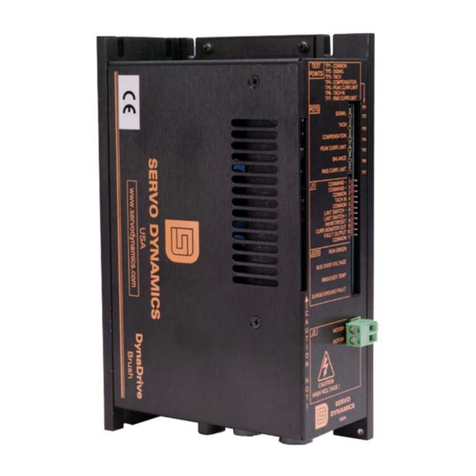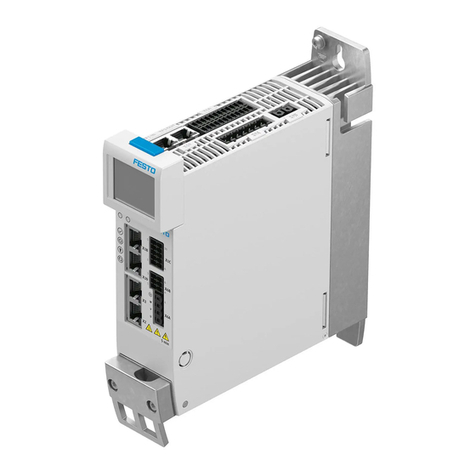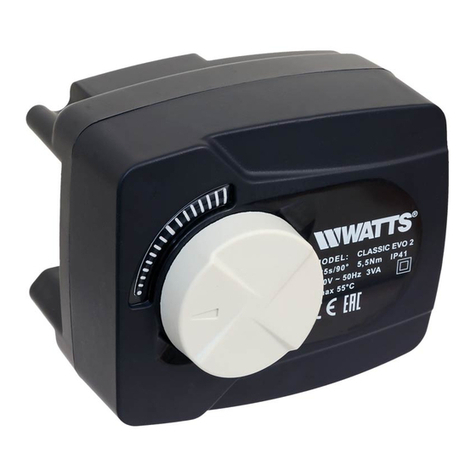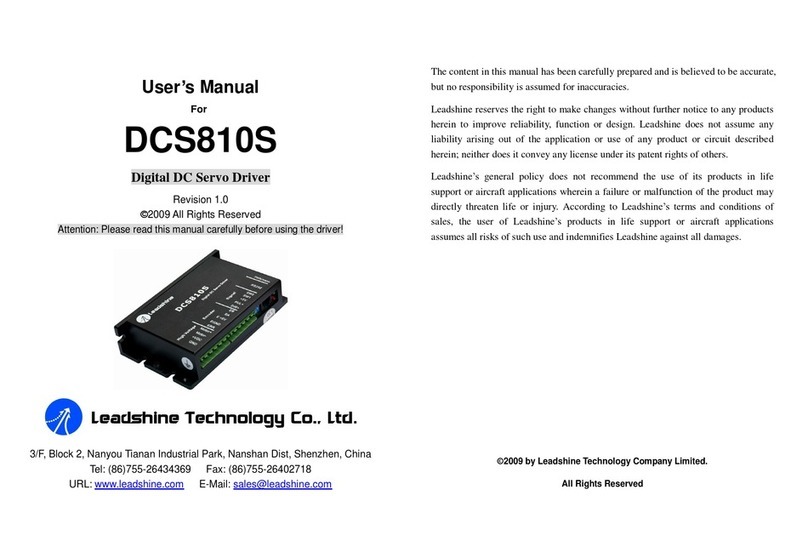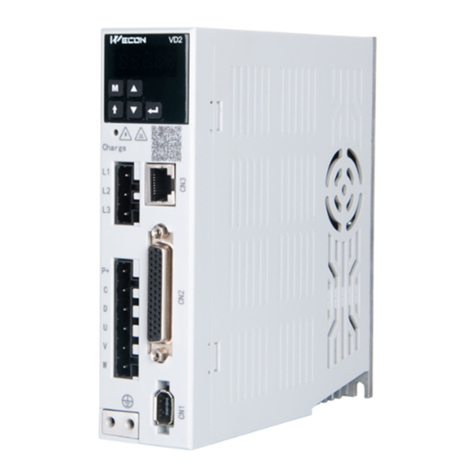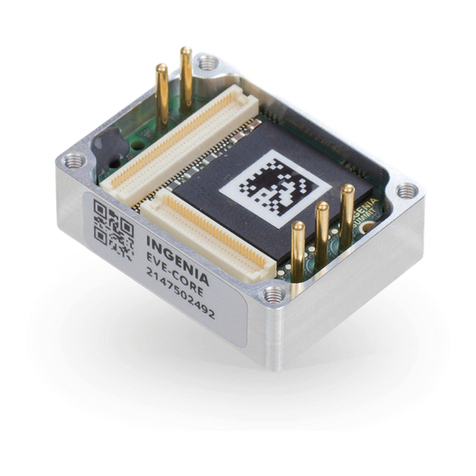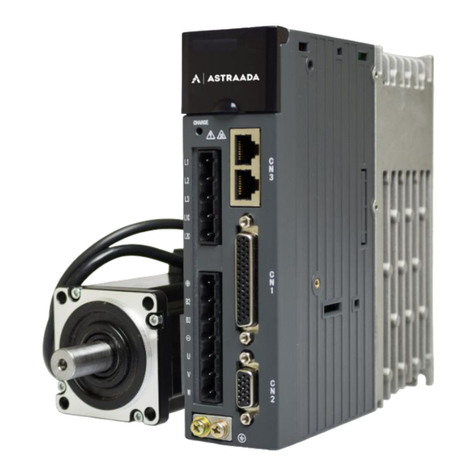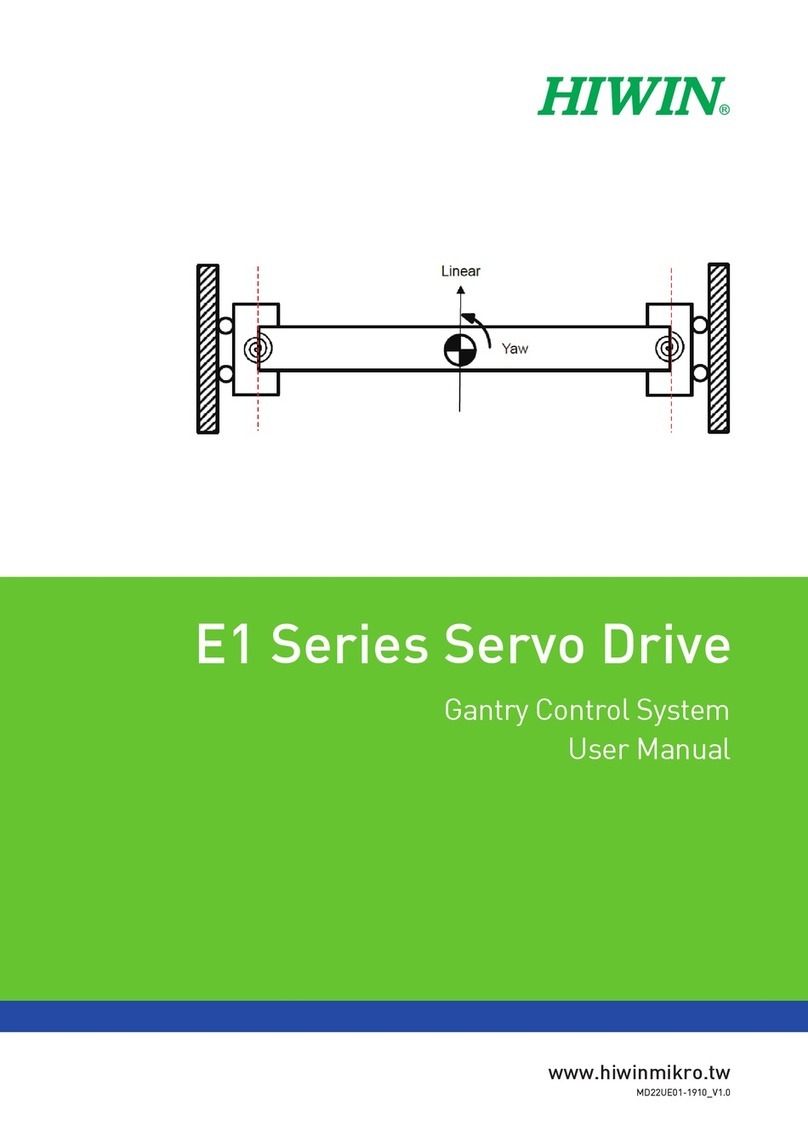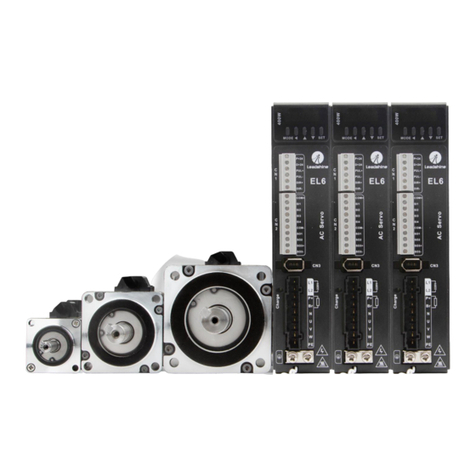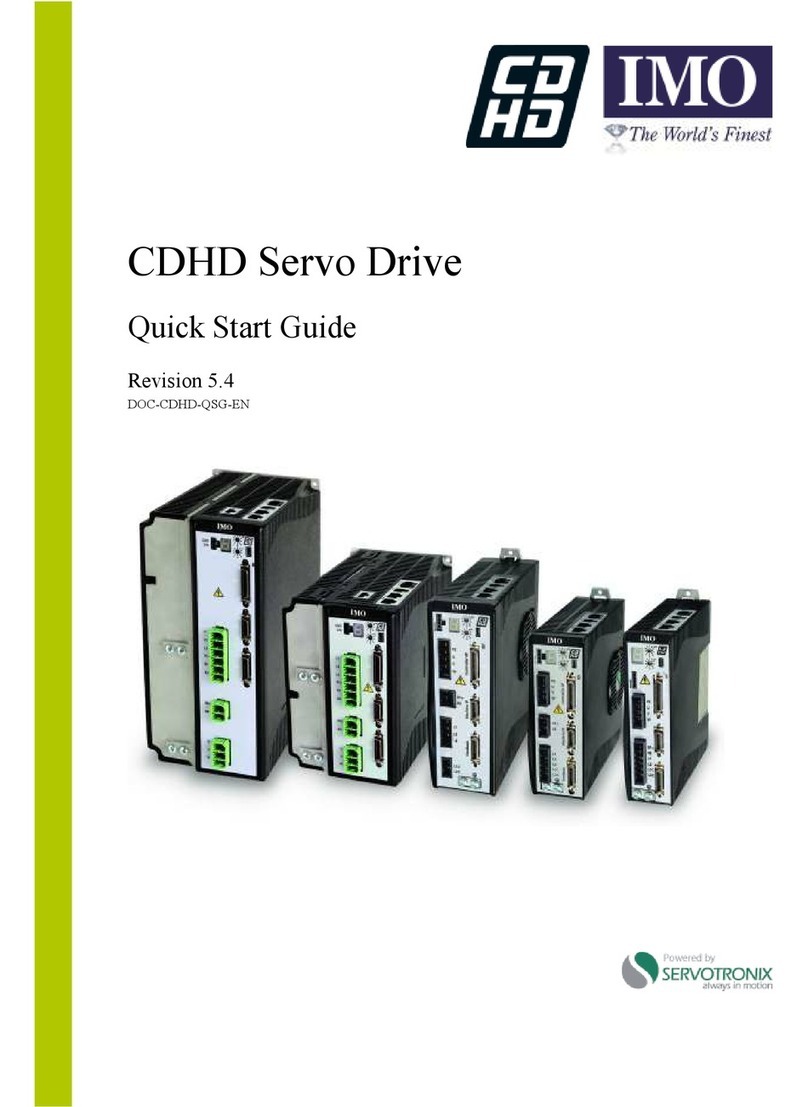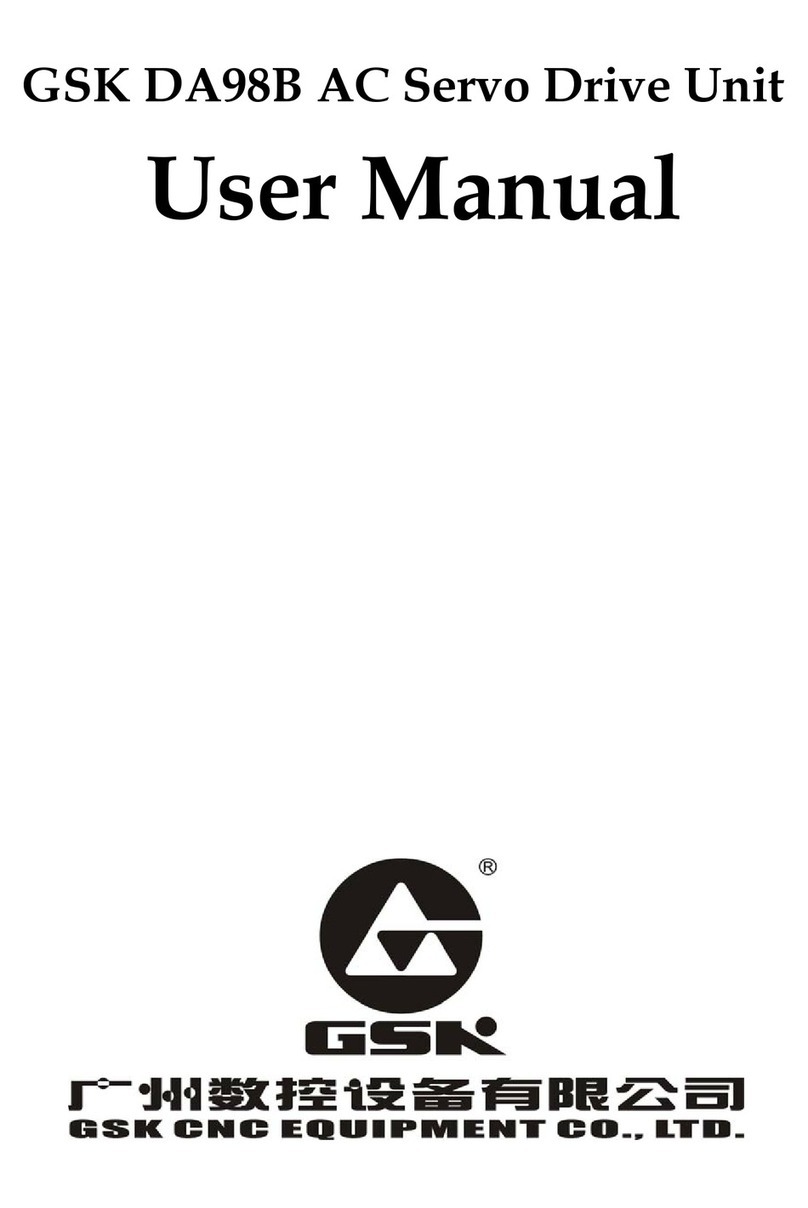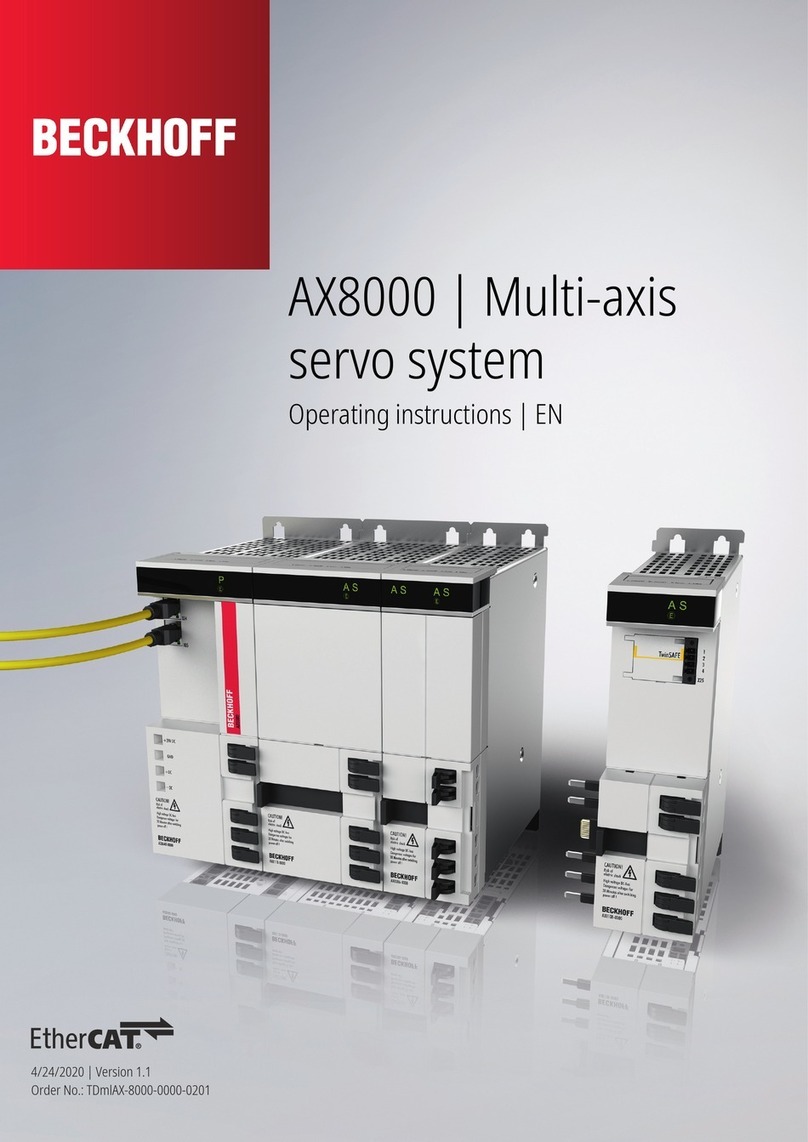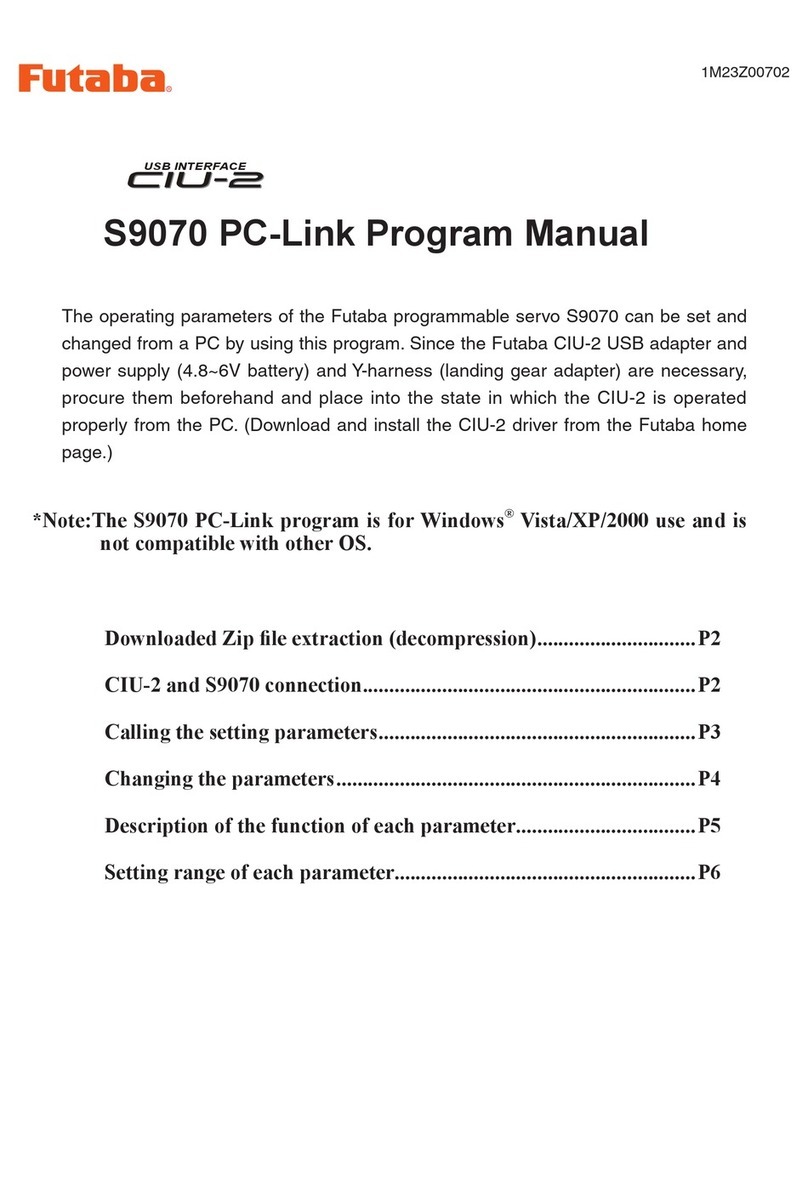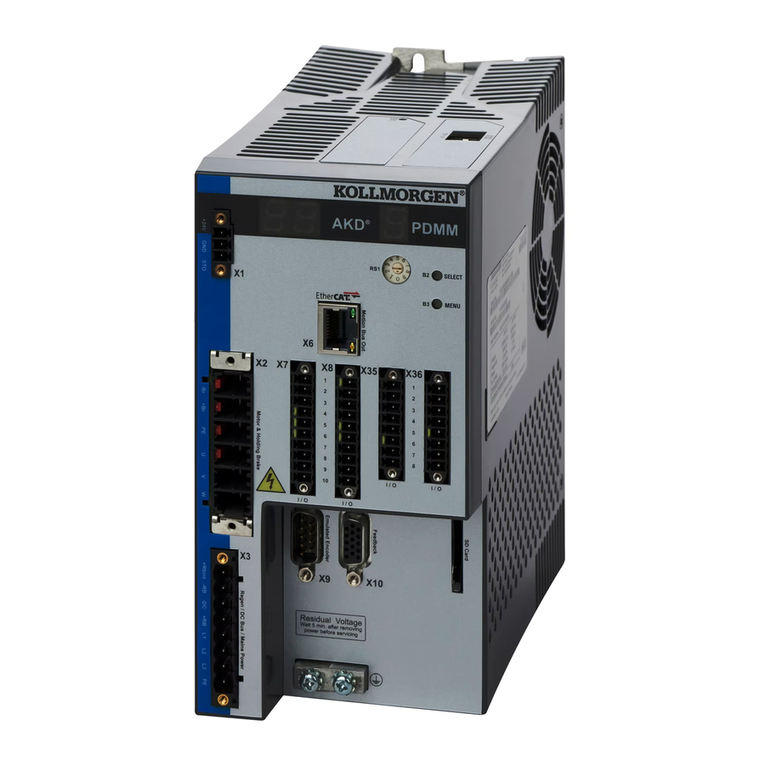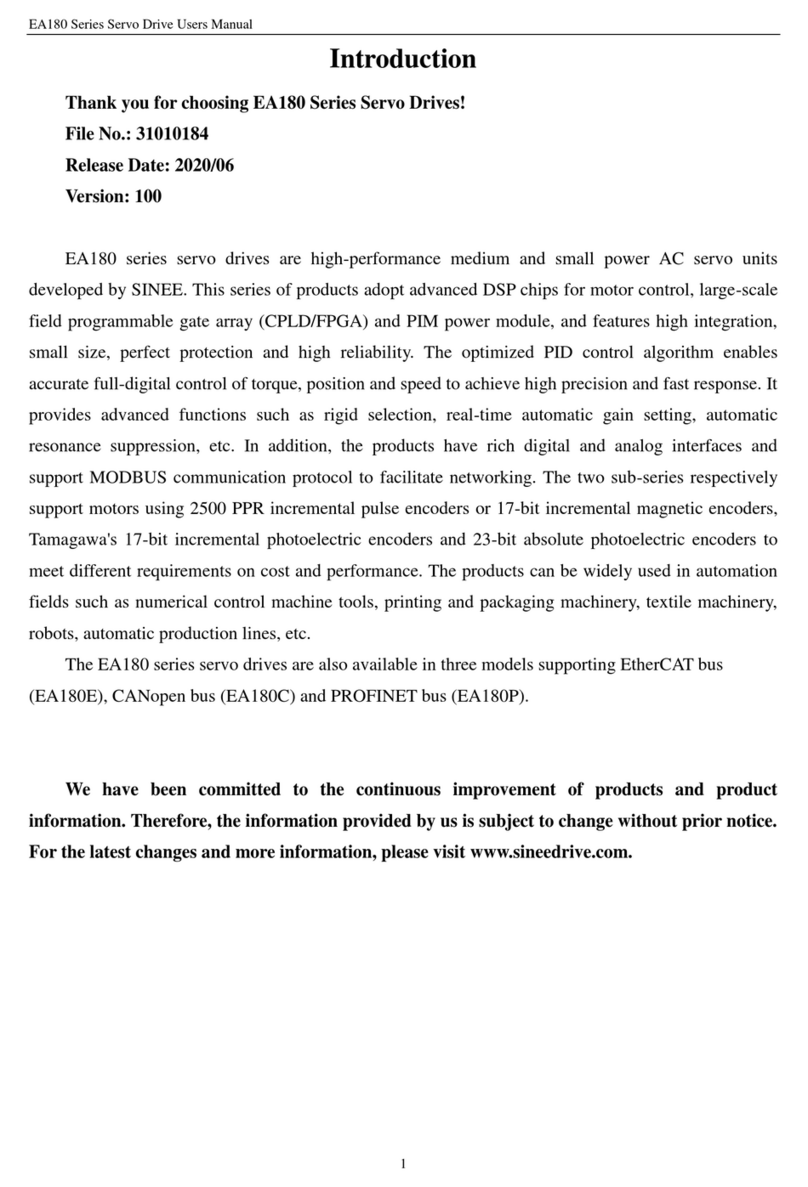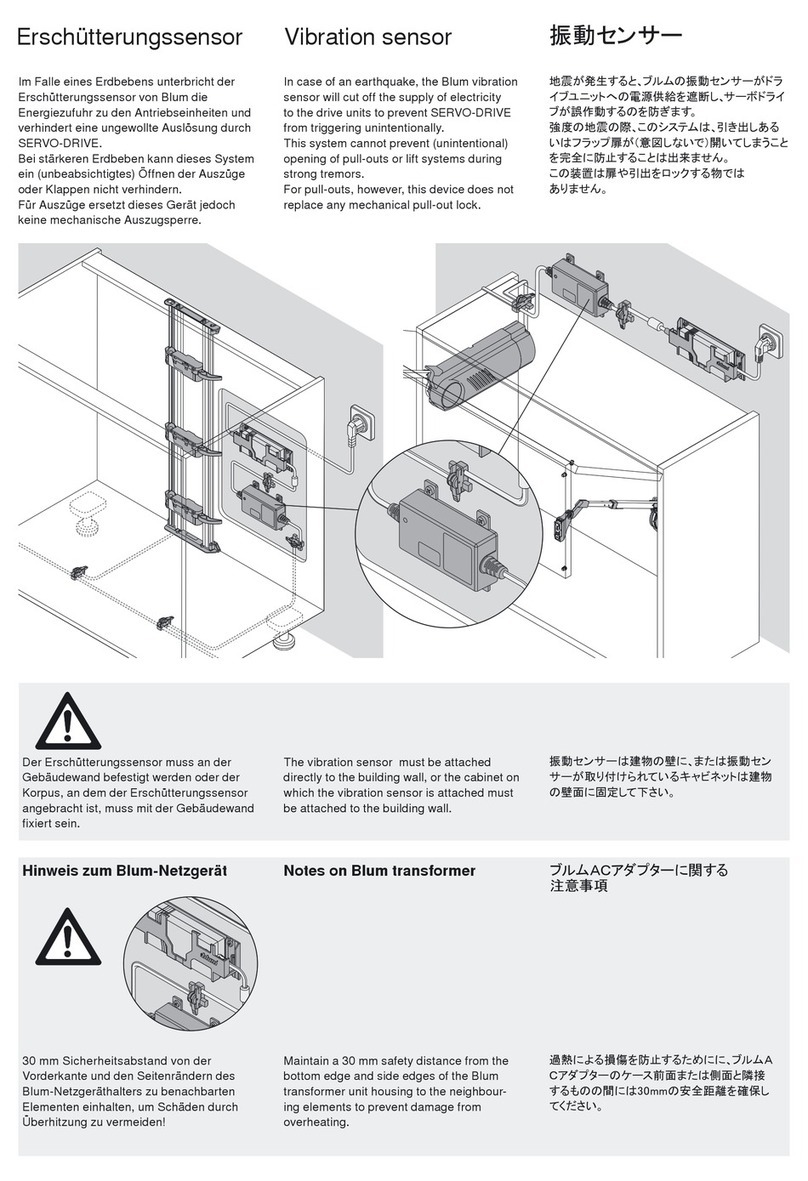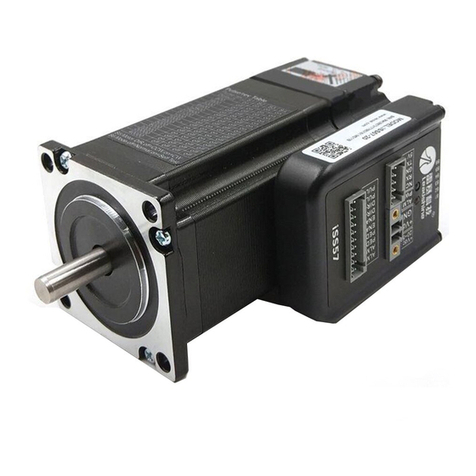Servo Dynamics 1224-BL User manual

\
1224-BL
SERVO AMPLIFIER
FOR BRUSHLESS SERVOMOTORS
USER GUIDE
October 2004

DynaDrive 1224-BL User Guide Page 2
Important Notice
This document is subject to the following conditions and restrictions:
• This document contains proprietary information belonging to Servo Dynamics. This
information is provided for the purpose of assisting users of the servo drive in its
installation.
• The text and graphics in this document are for the purpose of illustration and reference
only.
• The information in this document is subject to change without notice.
Revision History:
Version 1.01: October 28, 2004
Version 1.00: October 4, 2000

Contents
DynaDrive 1224-BL User Guide Page 3
1. Introduction........................................................................................................................... 4
1.1 Description...................................................................................................................... 4
1.2 Technical Specifications ................................................................................................. 5
2. Safety Information................................................................................................................ 6
2.1 Electrical Cautions.......................................................................................................... 6
3. Installation............................................................................................................................. 7
3.1 Matching the DynaDrive to the Motor............................................................................ 7
3.2 Mounting Dimensions..................................................................................................... 8
3.3 Connector Information.................................................................................................... 9
3.3.1 J1 – Control I/O Connection ................................................................................................... 9
3.3.2 J4 and J2 - Servomotor Connection ...................................................................................... 10
3.4 Wiring Diagram ............................................................................................................ 11
3.4.1 DynaDrive 1224-BL and Motor with Hall Sensors............................................................... 11
3.4.2 DynaDrive 1224-BL and Motor with Encoder with Hall Tracks.......................................... 12
3.5 Potentiometers -Adjustments........................................................................................ 13
4. Operational Modes.............................................................................................................. 14
4.1 Torque Mode................................................................................................................. 14
4.1.1 Torque Mode – Factory Potentiometer Settings....................................................................14
4.1.2 Torque Mode - Setup ............................................................................................................15
4.2 Velocity Mode .............................................................................................................. 16
4.2.1 Velocity Mode – Factory Potentiometer Setting ................................................................... 16
4.2.2 Velocity Mode- Setup ........................................................................................................... 17
5. Troubleshooting .................................................................................................................. 18
5.1 Diagnostic LEDs........................................................................................................... 18
5.1.1 Green LED ............................................................................................................................ 18
5.1.2 Red LEDs:............................................................................................................................. 18
5.2 Other Conditions........................................................................................................... 19
5.3 Test Points..................................................................................................................... 20
5.4 Contact Information ...................................................................................................... 21

Introduction
DynaDrive 1224-BL User Guide Page 4
1. Introduction
This information manual provides the product specifications, wiring diagram, operational modes
(torque and velocity) and troubleshooting procedures for the brushless DynaDrive 1224-BL.
1.1 Description
The DynaDrive 1224-BL supplies 12 amps continuous current and 24 amps peak current at 300
VDC for a total of 7200 watts of continuous power. The DynaDrive is a current source type
PWM amplifier.
The DynaDrive is a power duplicator of the command signal. A battery, a motion controller, or a
signal generator can be the source of the command signal input.
Please read this manual thoroughly to the end as it contains important system information
and warnings.

Introduction
DynaDrive 1224-BL User Guide Page 5
1.2 Technical Specifications
Performance Characteristics
Peak Power 7.2 kW
Peak Output Voltage ± 300 vdc (shut off @ 450 vdc)
Peak Output Current ± 24 amps (1 sec.)
Max. Continuous Current ± 12 amps (50 °C)
Electrical Characteristics
± 10 vdc (typ.),
Input Signal Voltage
± 35 vdc (max.)
0 to 5,100 amps/volt –velocity mode
System Gain
0 to 10.0 amps/volt – torque mode
Input Impedance 40 k Ohms
Typical Input Drift 10 µV/°C
Bandwidth 2 kHz with 2.4 mHy Inductance
Dead Band Zero
Input Power Requirements
Input Voltage 70 - 360 vdc
Adjustments
Peak Current Limit 0 to 24 amps
RMS Current Limit 0 to 12 amps
Signal Command Input Scaling
Balance Zero velocity/torque offset
Compensation System response
Tachometer Scaling
Diagnostics LED indication
Green LED 1 – RUN GREEN - AMPLIFIER OPERATIONAL
Red LED 2 – BUS OVER VOLTAGE
Red LED 3 – EXCESSIVE RMS CURRENT/ OVER TEMP
Red LED 4 – SURGE/GROUND FAULT
Physical Characteristics
Module Dimensions (L x W x H) 7.6 in. x 1.3 in. x 5.4 in.
Weight 1.8 lbs
Ambient Temperature – Operating 0 °C to 50 °C
Shutdown Temperature 80 °C at heat sink
Relative Humidity 5 - 95% non-condensing
Table 1: Technical Specifications for DynaDrive 1224-BL

Safety Information
DynaDrive 1224-BL User Guide Page 6
2. Safety Information
2.1 Electrical Cautions
Make sure that all voltages and tests are made with battery powered or electrically isolated
instruments.

Installation
DynaDrive 1224-BL User Guide Page 7
3. Installation
3.1 Matching the DynaDrive to the Motor
The factory preset potentiometer settings of the DynaDrive 1224-BL may need to be adjusted to
match the continuous current rating of your motor. To accomplish this, find the continuous
current rating of the motor to be used and adjust the RMS, PEAK CURR LIMIT and SIGNAL
pot per Table 2 below. If the continuous current rating is between the values shown in the table,
you may set to the lower value or use linear interpolation for each pot value. The signal pot
settings are based on +/- 10 vdc input command signal.
Continuous Current
Rating of Motor
(Amps)
RMS
Pot Setting
TP7
K Ohms (Amps)
PEAK CURRENT LIMIT Pot
Setting
TP5
K Ohms (Amps)
SIGNAL
Pot Setting
TP2
K Ohms
3 0.25 (3 Amps) 0.38 (9 Amps) 1.5
6 4.6 (6 Amps) 0.89 (18 Amps) 2.8
9 8.2 (9 Amps) 1.4 (24 Amps) 3.8
12 10.5 (12 Amps) 1.4 (24 Amps) 3.8
Table 2: Motor Specs
Note: All Measurements are with respect to TP1 (Common) with J1 removed.

Installation
DynaDrive 1224-BL User Guide Page 8
3.2 Mounting Dimensions
Note: Units in inch

Installation
DynaDrive 1224-BL User Guide Page 9
3.3 Connector Information
3.3.1 J1 – Control I/O Connection
J1 Label Description
1 +12V, 5mA OUT Auxiliary voltage that has 1K ohm resistor in series with this
output.
2 COMMON Connected to the other commons and connected to the
metalwork of the amplifier mounting plate.
3 -12V, 5mA OUT Auxiliary voltage that has 1K ohm resistor in series with the
output.
4 COMMAND- Differential input. This pin can also be used as a single ended
input. Use J1, Pin 2 as common.
5 COMMAND+ Differential input
6 TACH IN Single ended input that has additional tach filtering and
conditioning.
7 ENCODER to TACH
OUT (option) Jumper to Pin 6 if Encoder to Tach option Is being used.
8 CURR MONITOR OUT Current monitor output. +/- 10 Vdc out equals approx. +/- 24
amps.
9 INHIBIT/RESET Connect to +5Vdc to enable amplifier. Remove +5Vdc to inhibit
and reset amplifier.
10 HALL VOLTAGE OUT +5Vdc to hall sensors (30 mA max)
11 COMMON Common connection for hall sensors. See Pin 2 above.
12 HALL 1 Internally pulled up to +5 Vdc.
13 HALL 2 Internally pulled up to +5 Vdc
14 HALL 3 Internally pulled up to +5 Vdc
15 COMMON See Pin 2 above
16 FAULT OUTPUT
Uncommitted collector output that is high (On) during normal
operation and low (Off) if a fault occurs. Note: Use an external
pull up resistor to 5 – 24 Vdc at 10 mA max.

Installation
DynaDrive 1224-BL User Guide Page 10
3.3.2 J4 and J2 - Servomotor Connection
J4 Label Description
1 N.C. No connection
2 Enc (B) Encoder (B) input for Enc. to Tach
3 N.C. No connection
4 Enc (A) Encoder (A) input for Enc. to Tach
5 Enc. Common Encode Ground
J2 Label Description
1 MOTOR(U) Output power to motor
2 MOTOR(V) Output power to motor
3 MOTOR(W) Output power to motor
4 - DC BUS IN DC Bus Return
5 + DC BUS IN DC Bus High Side

Installation
DynaDrive 1224-BL User Guide Page 11
TP1 COMMON
TP2 SIGNAL
TP3 TACH
TP4 COMPENSATION
TP5 PEAK CURRENT LIMIT
TP6 TACH SIGNAL INPUT
J1 CONNECTOR
PIN 1 12 V, 5mA OUT
PIN 2 COMMON
PIN 3 12 V, 5mA OUT
PIN 4 COMMAND
PIN 5 COMMAND
PIN 6 TACH IN
PIN 7 ENC. TO TACH OUT
PIN 8 CURR. MONITOR OUT
PIN 9 INHIBIT/RESET
PIN 10 HALL VOLTAGE OUT (+6V @15mA)
PIN 11 COMMON
PIN 12 HALL 1 (B )
PIN 13 HALL 2 (A )
PIN 14 HALL 3 (C )
PIN 15 COMMON
PIN 16 FAULT OUTPUT
J2 CONNECTOR
PIN 1 MOTOR (U)
PIN 2 MOTOR (V)
PIN 3 MOTOR (W)
PIN 4 DC BUS IN
PIN 5 DC BUS IN
TEST POINTS
POTS
SIGNAL
TACH
COMPENSATION
PEAK CURR. LIMIT
MOTOR
HALL
SENSORS
BALANCE
TP7 RMS
TORQUE MODE
JUMPER J3
RMS
DynaDrive 1224-BL
CONN. J2
RMS/OVER TEMP.
BUS OVER VOLTAGE
RUN GREEN
LEDs
SURGE/GROUND FAULT
PIN 1 PIN 16
11112
13 14 16
PIN 1 PIN 5
TP8
10
CONN. J1 CONN. J4
150-260 VAC
MDA 25
+
BLEEDER
RESISTOR
-
3.4 Wiring Diagram
3.4.1 DynaDrive 1224-BL and Motor with Hall Sensors

Installation
DynaDrive 1224-BL User Guide Page 12
TP1 COMMON
TP2 SIGNAL
TP3 TACH
TP4 COMPENSATION
TP5 PEAK CURRENT LIMIT
TP6 TACH SIGNAL INPUT
TEST POINTS
POTS
SIGNAL
TACH
COMPENSATION
PEAK CURR. LIMIT
MOTOR
ENCODER
BALANCE
EXTERNAL
POWER SUPPLY
+5VDC
Comm
+5 VDC
TP7 RMS
TORQUE MODE
JUMPER J3
RMS
DynaDrive 1224-BL
CONN. J1
RMS/OVER TEMP.
BUS OVER VOLTAGE
RUN GREEN
LEDs
SURGE/GROUND FAULT
PIN 1 PIN 16
11112131416
TP8
CONN. J4
PIN 5PIN 1
CONN. J2
J1 CONNECTOR
PIN 1 12 V, 5mA OUT
PIN 2 COMMON
PIN 3 12 V, 5mA OUT
PIN 4 COMMAND
PIN 5 COMMAND
PIN 6 TACH IN
PIN 7 ENC. TO TACH OUT
PIN 8 CURR. MONITOR OUT
PIN 9 INHIBIT/RESET
PIN 10 HALL VOLTAGE OUT (+6V @15mA)
PIN 11 COMMON
PIN 12 HALL 1 (B )
PIN 13 HALL 2 (A )
PIN 14 HALL 3 (C )
PIN 15 COMMON
PIN 16 FAULT OUTPUT
J2 CONNECTOR
PIN 1 MOTOR (U)
PIN 2 MOTOR (V)
PIN 3 MOTOR (W)
PIN 4 DC BUS IN
PIN 5 DC BUS IN
150-260 VAC
-
MDA 25
+
BLEEDER
RESISTOR
3.4.2 DynaDrive 1224-BL and Motor with Encoder with Hall Tracks

Installation
DynaDrive 1224-BL User Guide Page 13
3.5 Potentiometers -Adjustments
The following is a description of the function of each pot. The pot settings can be measured at
test points TP1 thru TP7.
Potentiometer Description
SIGNAL
The signal potentiometer is used for scaling the command signal.
Turning the potentiometer CW increases the amount of command
signal to the front end of the amplifier.
TACH
The tachometer potentiometer is used for scaling the various
tachometer voltage gradients. This input has to be used because
of special signal conditioning. Turning the pot CW increases the
amount of tach-feedback into the amplifier.
COMPENSATION
The Compensation potentiometer is used to increase or decrease
the response (bandwidth) of the amplifier. Turning the
potentiometer CW increases the response of the amplifier.
PEAK CURR LIMIT
The peak current limit potentiometer is used to increase or
decrease the peak output current of the amplifier. Turning the
potentiometer CW increases the output current of the amplifier
from zero amps to maximum peak amps.
BALANCE
The balance potentiometer is used to stop motor rotation when no
input signal exists. The function of this pot is such that for zero
input volts the output current should be at zero amps.
RMS
The RMS potentiometer is for changing the level of the RMS
current. The amplifier is capable of providing maximum RMS
current when fully CW. The minimum current is approximately 0
amps when fully CCW.

Operational Modes
DynaDrive 1224-BL User Guide Page 14
4. Operational Modes
The DynaDrive can operate in a Torque or Velocity mode.
In the Torque mode, the DynaDrive only closes the torque loop. The velocity loop is closed in
the motion controller.
In the Velocity mode, the DynaDrive itself closes both the torque and velocity loop. Unless
otherwise specified, the DynaDrive 1224-BL is preset from the factory in the torque mode.
4.1 Torque Mode
4.1.1 Torque Mode – Factory Potentiometer Settings
The DynaDrive 1224-BL is shipped in the torque mode by installing the torque mode jumper at
J3 and presetting the potentiometers for the torque mode. The factory potentiometer settings for
the torque mode are as follows: (See ADJUSTMENTS section for a more complete description
of the potentiometer functions)
Potentiometer
Description
Potentiometer
Setting
Potentiometer
Test Point
N/A N/A TP1 – COMMON
SIGNAL 4.0 k Ohms TP2 – SIGNAL
TACH Full CCW TP3 – TACH
COMPENSATION Full CW TP4 – COMPENSATION
PEAK CURR LIMIT 1.4 k Ohms
(24 Amps) TP5 – PEAK CURR LIMIT
BALANCE No Preset None
RMS 10.5 k Ohms (12 Amps) TP7 – RMS
Table 3:Torque Mode POT settings
Note: All Measurements are with respect to TP1 (Common) with J1 removed.

Operational Modes
DynaDrive 1224-BL User Guide Page 15
4.1.2 Torque Mode - Setup
The factory preset potentiometer settings are adjusted for the torque mode operation.
To set up and run the DynaDrive 1224-BL in the torque mode, perform the following:
1. Turn power off.
2. Remove J1.
3. Check all wiring connections. Verify that J3 jumper is installed.
4. Set the RMS, PEAK CURRENT LIMIT and SIGNAL pots to match the motor as
indicated in Table 2. For preliminary testing under no load, use the factory preset pot
settings.
5. Check that the TACHOMETER pot is full counterclockwise (CCW).
6. Check that the COMPENSATION pot is full clockwise (CW).
7. Replace J1.
8. Inhibit the DynaDrive by leaving pin 9 of J1 open or by pulling to common.
9. Turn power on.
10. Insure that the voltage at COMMAND + and COMMAND – is zero.
11. Enable the DynaDrive by pulling pin 9 of J1 to + 5 VDC
12. The green LED should be the only LED on. No other LEDs should be on at this point. If
any other situation exists, check the TROUBLESHOOTING section of this manual.
13. Adjust the BALANCE pot to give 0.15 volts at CURRENT MONITOR OUT, J1 pin 8.
14. Apply a voltage (0 to +/- 10 VDC) at COMMAND + and COMMAND -. The motor
shaft should turn CW when COMMAND + is positive and should turn CCW when
COMMAND + is negative. At low COMMAND voltage, holding the shaft can stall the
motor. At higher COMMAND voltage, the torque is much greater and it should be
difficult to stall the motor.

Operational Modes
DynaDrive 1224-BL User Guide Page 16
4.2 Velocity Mode
4.2.1 Velocity Mode – Factory Potentiometer Setting
To set the DynaDrive in the Velocity Mode, remove the cover to expose the Torque Mode
Jumper at J3. Remove the Torque Mode Jumper at J3 that is located right behind the Tach pot.
The pot settings must be adjusted for Velocity mode per Table 3 below. The Velocity mode
requires a tachometer feedback signal from the motor or motion control system.
To match the motor to the DynaDrive 1224-BL, set the RMS and SIGNAL pots per Table 2. Set
the PEAK CURR LIMIT pot to full CCW. Set the remaining pots per Table 3 below. Now
perform the Velocity Mode Setup procedure on the next page.
Potentiometer
Description
Potentiometer
Setting
Potentiometer
Test Point
N/A N/A TP1 – Common
SIGNAL See Table 2 TP2 – SIGNAL
TACH 7.0 k Ohms TP3 – TACH
COMPENSATION Full CCW TP4 – COMPENSATION
PEAK CURR LIMIT Full CCW TP5 – PEAK CURR LIMIT
BALANCE No Preset None
RMS See Table 2 TP7 – RMS
Table 3: Velocity Mode POT settings
Note: All Measurements are with respect to TP1 (Common) with J1 removed.

Operational Modes
DynaDrive 1224-BL User Guide Page 17
4.2.2 Velocity Mode- Setup
To set up and run the DynaDrive 1224-BL in the Velocity mode, perform the following:
1. Turn power off.
2. Remove J1.
3. Check all wiring connections. Verify that J3 jumper is removed.
4. Check that the pots are set per Table 3.
5. Inhibit the DynaDrive by leaving pin 9 of J1 open or by pulling it to common.
6. Replace J1.
7. Turn power on.
8. Insure that the voltage at COMMAND + and COMMAND – is zero.
9. Enable the DynaDrive by pulling pin 9 of J1 to + 5 VDC.
10. The green LED should be the only LED on. No other LEDs should be on at this point. If
any other situation exists, check the TROUBLESHOOTING section of this
manual.Slowly turn the PEAK CURR LIMIT pot CW. If the motor runs away, turn the
power off, reverse the velocity feedback leads and repeat above. If the motor does not
run away, turn power off and wait for the green LED to go out, disconnect J1. Set the
PEAK CURR LIMIT pot to the value given in Table 2. Re-install J1, turn power on and
continue.
11. Turn the COMPENSATION pot CW until the motor starts buzzing. Now turn the pot
CCW until the motor stops buzzing and then turn another 1 ½ turns CCW.
12. The motor shaft should not be rotating at this point. If it is slowly rotating, adjust the
BALANCE pot until rotation is stopped.
13. With zero voltage at COMMAND + and COMMAND –, the motor shaft should be stiff
and difficult to turn. A low voltage at COMMAND + will cause the motor to turn at a
slow speed with high torque and the motor should be difficult to stall. The motor speed
should be proportional to the COMMAND voltage.

Troubleshooting
DynaDrive 1224-BL User Guide Page 18
5. Troubleshooting
5.1 Diagnostic LEDs
The DynaDrive 1224-BL has four diagnostic LEDs:
1) RUN GREEN
2) BUS OVER VOLTAGE
3) RMS/ OVER TEMP
4) SURGE/ GROUND FAULT
5.1.1 Green LED
RUN GREEN - Indicates the amplifier is working properly. When the green LED goes OFF and
there is no red LEDs ON, the following may have occurred:
1. Loss of power to the amplifier.
2. Bus Voltage less than 200 VDC.
3. Amplifier has been inhibited by J1, Pin 9.
5.1.2 Red LEDs:
Note: When a red LED is ON, the amplifier has been inhibited and remains inhibited until reset.
To reset, toggle J1 pin 9 momentarily to Common.
5.1.2.1 BUS OVER VOLTAGE
Indicates that the bus voltage has exceeded 450 VDC. This condition may be caused by rapid
deceleration or back driving of the motor. A shunt regulator is required to dissipate the motor
energy. If a shunt regulator is present in the system check its fuses.
5.1.2.2 RMS/OVER TEMP
• Excess RMS - The amplifier delivered current beyond its continuous capability. This
condition can exist if a machine is asked to perform a task greater than its design
capabilities. This would include a motor that is mechanically stalled or binding or a
motor with shorted stator (armature) wires.
• Over temperature - The heat sink has exceeded 80 °C. An over temperature condition
may exist for the following reasons:
1. Insufficient airflow across the heat sink.
2. Ambient cabinet temperature too high.

Troubleshooting
DynaDrive 1224-BL User Guide Page 19
5.1.2.3 SURGE/GROUND FAULT
• Surge - Indicates an excessive amount of current through the power transistors in the
output power bridge. This condition may be due to a damaged output power device or
shorted output leads to the motor.
• Ground fault - One of the output wires to the motor is shorted to ground. This condition
may be due to faulty or pinched wiring or the motor is arcing to the case ground.
5.2 Other Conditions
Problem Possible Solution
MOTOR OR MACHINE
RUNS AWAY
1.Check the tachometer voltage to the amplifier by testing TP3
with respect to TP1. Then look at TP6 with respect to TP1 with a
voltmeter.
2.Ensure the tachometer signal is phased correctly.
3.Check to see if the position loop phasing (CNC command) is
correct relative to the position encoder feedback device.
MOTOR RUNS ERRATIC
OR PRODUCES VERY
LOW TORQUE IN
VARIOUS SHAFT
POSITIONS
1. Check the phase relationship of the motor commutator (Hall)
sensors wires (J1, Pins 12, 13, and 14) relative to the motor power
wires at the motor terminals of the amplifier chassis.
2. Check the wires from the motor commutator sensors and make
sure the motor commutator signals are making connection in J1,
Pins 12, 13 and 14 on the connector on the amplifier module.

Troubleshooting
DynaDrive 1224-BL User Guide Page 20
5.3 Test Points
Test Point Pin Observed Signal
TP1 COMMON
TP2 SIGNAL input POT wiper
TP3 TACH input wiper
TP4 COMPENSATION POT wiper
TP5 PEAK CURR LIMIT POT wiper
TP6 TACH IN signal directly connected to J1, pin 6 thru a 10K resistor
TP7 RMS current setting pot wiper
TP8 Front-end opamp output (J3, pin 2)
Table of contents
Other Servo Dynamics Servo Drive manuals
